Initial Processing

Initial Processing of Meteorites
The initial processing of meteorites collected from the icy realms of Antarctica consists of defrosting process, initial descriptions, sample separation, preparation of analytical samples (thin sections), textural observation and compositional analysis, and publication and database registration.
Thawing Process
Meteorites collected in Antarctica are transported to the National Institute of Polar Research frozen and stored in a large freezer (-20°C). They undergo a specialized thawing process to avoid rust formation due to water condensation. To thaw the meteorites, they are first placed in acrylic vacuum desiccators in a freezer. The sample is then moved to a room temperature environment, depressurized by a vacuum pump, and allowed to dry for half a day to a day. The dried meteorites are placed in sample bags (plastic or Teflon bags) and stored in the meteorite storage room.
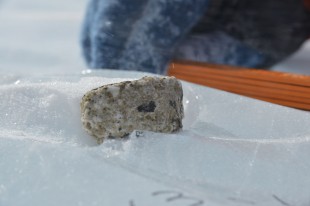
Meteorite on Bare Ice
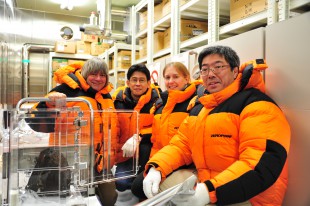
Inside the Large Freezer at the National Institute of Polar Research
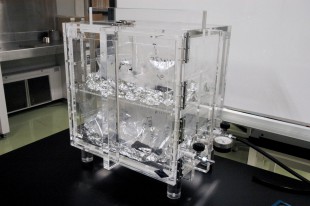
Vacuum Desiccator for Meteorite Defrosting
Initial Description
After reaching room temperature, the meteorites are again identified by researchers and, with the exception of obviously terrestrial rocks, are renamed from their field names to their official names. After the name is determined, the weight and size (in three directions) of the meteorite are measured. Then, an initial description of the shape and appearance is made. Finally, photographs are taken (six directions) and these data are registered in a database.
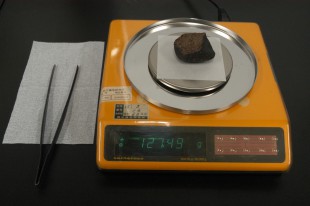
Meteorite Weighing
Sample Separation
When the sample is separated into smaller pieces, it is processed in the meteorite processing room. The meteorites are either broken up with a hammer and chisel or cut with a diamond wire saw. No water or other liquids are used in these processes. The meteorite processing room is positively pressurized (air always flows from the room to the outside) to prevent dust and debris from entering from the corridor and front room.
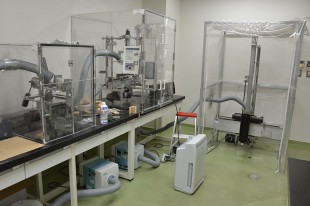
Meteorite Processing Room
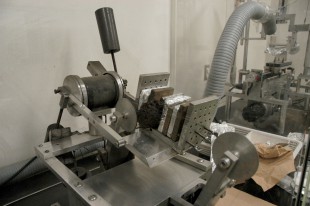
Wire Saw for Meteorite Cutting
Preparation of Analytical Samples (Thin Sections)
Small pieces separated in the meteorite processing room are used to prepare polished thin sections for observation of petrographic texture and analysis of mineral composition. After embedding the small pieces in epoxy resin, one side is ground flat and attached to a circular glass slide (2.5 cm diameter silica glass). The glass slide is then ground to the desired thickness using a grinder, and finally polished to a mirror finish using diamonds paste. The finished polished thin section will have a sample thickness of 0.03 mm.
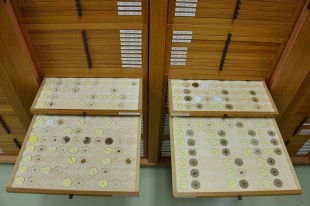
Storage Shelf for Meteorite Thin Sections
Textural Observation and Compositional Analysis
The composition of minerals (olivine, pyroxene, and plagioclase) are measured using an electron microprobe analyzer (JEOL JXA-8200) on the prepared polished thin sections. Based on the mineral composition data and the observation of the petrographic texture by the researcher, the meteorite is placed into a classification.
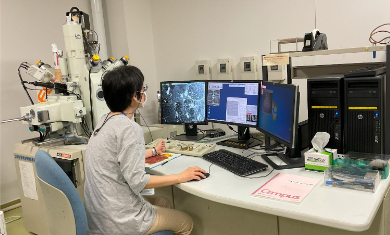
Electron Microprobe Analyzer
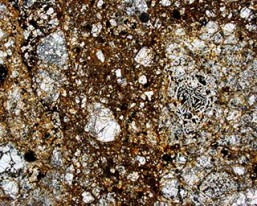
Meteorite Thin Section
Publication and Database Registration
The fundamental classification data (meteorite name, classification, composition data, etc.) will be published in a catalog (Meteorite Newsletter) and made publicly available. The published meteorites will be widely distributed to researchers as research samples. The data will also be registered in the Antarctic Meteorite Database. At the same time, the data will be submitted to the Nomenclature Committee of the Meteoritical Society for official approval.



